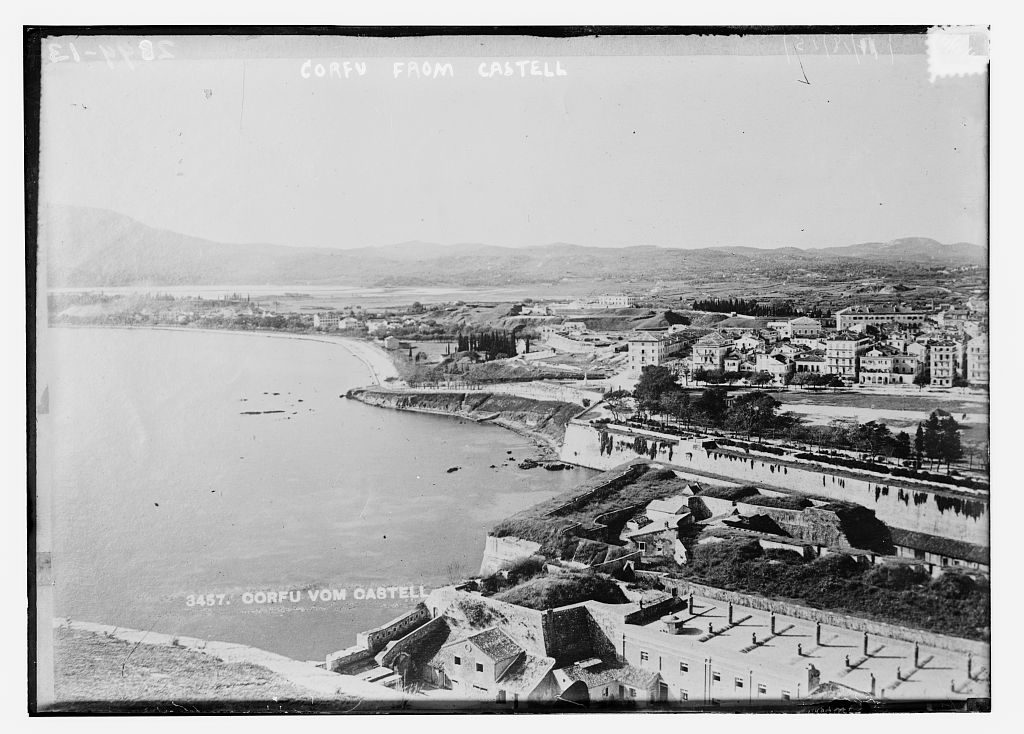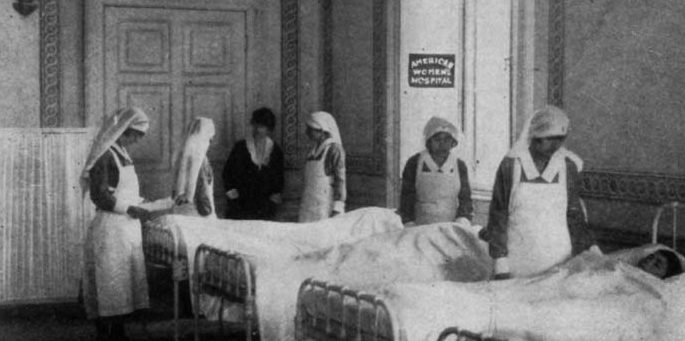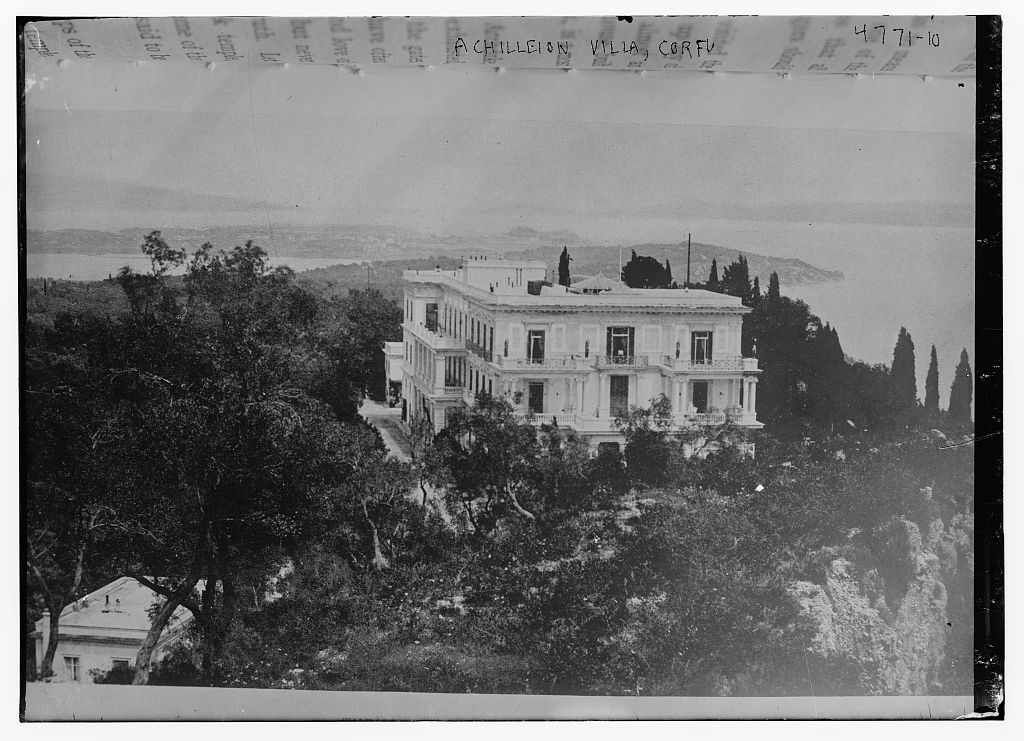LOVE, TRAGEDY, SURVIVAL: Near East Relief in Corfu
Two thousand Near East Relief orphans found a temporary home — and two dedicated relief workers found love — in a gleaming palace by the sea. Sadly, the shores of Corfu were also the site of a great tragedy.

View of Corfu, c. 1910. Library of Congress.

A DISPUTED PARADISE
Corfu: an island paradise with a tumultuous past. By the 1920s, the sickle-shaped island off the northwest coast of Greece had a long history as a disputed territory. Over the centuries the island passed from Greek, to Venetian, to Ottoman control in a series of devastating sieges. Despite these difficulties, Corfu was a place of incredible natural beauty.
In 1890, the Empress Elisabeth of Bavaria chose Corfu as the site of her new vacation palace. She built the Achilleion, a gleaming white palace with panoramic views of the island and the Ionian Sea. Located a few miles south of the city of Corfu, the Achilleion served as both a relaxing summer residence and a monument to the Empress’s late son. The name “Achilleion” was an homage to the mythological Greek hero Achilles. The lavish gardens that surrounded the grand palace were punctuated by Classical Greek sculptures of the building’s namesake.
Kaiser Wilhelm II of Germany purchased the property in 1907. He continued to use the Achilleion as a summer residence. It was also a site of important diplomatic meetings between the Kaiser and other leaders. When World War I began, the Greek government seized the palace under the Alien Property Act because it was owned by a foreign (and enemy) power; Germany continued to assert a claim to the Achilleion for many years.
PALACES AND WAREHOUSES
In late 1922, the empty palace found a new purpose. The Achilleion was one of many Greek government buildings loaned to Near East Relief for use as an orphanage in the wake of the Smyrna disaster and the evacuation from Turkey.
A group of 3,000 orphans arrived in Athens in late November 1922. They traveled on the steamships Belgravian and Carnaro. A committee of Greek leaders, including General Tsiporas and his American-born wife, Mary White, officially welcomed the children to Greece. Although many of the new arrivals were of Anatolian Greek heritage, their families had never lived in Greece. They did not understand the language in which the honored greeters addressed them. Greece was a strange and exotic land to all of the Near East Relief orphans.
Shortly after arriving, most of the children were on the road again. About 2,000 orphans made the long journey northwest from Athens to Corfu. Not all of the orphans were lucky enough to find a new home in a palace. In February 1923, Near East Relief official Charles V. Vickrey reported that he had recently visited with 1,000 boys living in the Achilleion, and an additional 1,400 boys living in an abandoned warehouse in the city of Corfu. The boys living in the warehouse were optimistic and creative despite their living conditions. Vickrey wrote that they slept on floors and on shelves stacked as high as the ceilings, but still made space for classes during the day. A nearby military fort, long abandoned, was home to an estimated 150 refugees.

I saw [the orphans] first on the island of Corfu, Greece, where so many have dreamed of an empire since the legendary days of Ulysses. There were hundreds of them up there in the outbuildings of Kaiser Wilhelm's former winter palace. Then 800 boys stood up and sang 'My Country, 'Tis of Thee' -- all four verses without a book. . . The hearts of their hearers broke."
LIFE AND LOVE AT THE ACHILLEION
Near East Relief collaborated with Save the Children, a London-based organization that was founded in 1919 to combat hunger. Save the Children’s Corfu director was an Armenian refugee named Mark (Margos) Keshishian, a Hadjin native and Genocide survivor. Keshishian and his wife were forced to leave Constantinople for Corfu in 1922. They devoted several years to the orphans of Corfu, and welcomed a baby son while living there.
Keshishian worked closely with several dedicated Near East Relief workers. Col. Stephen Lowe was Director of Relief for the island. Henry T. Kneeland of Hartford, CT, served as orphanage director. Emma Wood of Chicago supervised the orphans while also overseeing the infirmary at the Old Fort. American Women’s Hospitals nurse and Near East Relief worker Frances MacQuaide ran one of two AWH hospitals on the island. The busy hospital doubled as a nurse training school for refugee women. Grace Blackwell of Montclair, NJ, and Lelia Priest of Detroit, MI, also worked for Near East Relief in Corfu. By summer 1923, there were as many as 2,000 Near East Relief orphans living on the island, and countless refugees.
Against this dramatic backdrop, Emma Wood and Stephen Lowe fell in love. They planned a brief wedding trip for September 1923 . . . but life on Corfu was about to take a tragic turn.

Nurse Frances MacQuaide (in black) with refugee nurses at the American Women's Hospital in Corfu, 1923. From Certain Samaritans by Dr. Esther Pohl Lovejoy.
CAUGHT IN THE CROSSFIRE
Following the assassination of an Italian general in the mainland city of Ioannina, Greece, Mussolini’s Italian Navy launched a bombardment on the island of Corfu on August 31, 1923. The island was defenseless. The population was mostly orphans, refugees, and relief workers. They had no weapons, and the city of Corfu had no fortifications. The only fortress on the island was not only ancient, it had also been converted into a temporary shelter for orphans and refugees.
The shelling began at 4:30 in the afternoon. The Italian ships and airplanes targeted the Old Fort and the nearby beaches. Within half an hour all lines of communication off of the island had been severed. Relief workers hastily evacuated orphans and refugees … but they were too late to save a group that had just left for a late-afternoon swim in the Ionian Sea.
Emma Wood and Stephen Lowe were permitted to send one last cable from Corfu to Athens. It contained terrible news: 16 orphans and four adult refugees had died from shrapnel, shells, and machine gun fire on the beaches of Corfu. An additional 50 people were wounded, some severely.
The Italian government denied all requests to leave the island. Col. Lowe (his wedding to Miss Wood obviously postponed) met with the Italian admiral and obtained permission to continue Near East Relief’s work — although the admiral declined to guarantee the safety of the orphans, refugees, or relief workers.
These innocent orphans and refugees had survived unspeakable tragedy only to lose their lives in what became known as the “Corfu Incident.” After considerable diplomatic turmoil, including Italy’s threat to abandon the fledgling League of Nations, Mussolini recalled the Italian troops on September 27.

The Achilleion Palace in Corfu became a Near East Relief orphanage. Library of Congress.
AN EMPTY PALACE ONCE MORE
Life on Corfu was probably never quite the same after this tragedy. One can only imagine the fear that lingered in the hearts of the surviving orphans — children who had already been through so much in their short lives. The Achilleion had been a temporary home, and it was time for the children to move on again.
The Greek government granted Near East Relief a large parcel of land on the island of Syra (Syros) in the Cyclades. Near East Relief set out to build an ambitious orphanage and school system on Syra — an “Orphan Island” that could house many of the orphans living in temporary accommodations across Greece. Most of the orphans living in Corfu probably found a new, more permanent home in Syra.
By the end of 1924, the Achilleion was an empty palace once again. Today, visitors can roam the painted halls and lavish gardens of the palace just as the orphans once did. After a stint as a casino, the Greek government preserved the Achilleion for its beauty and historical significance. The building is now a museum.
